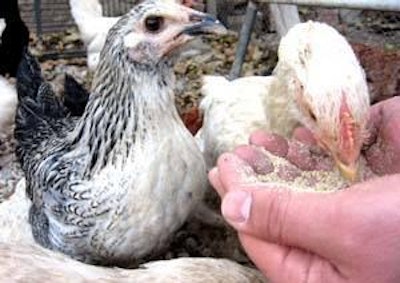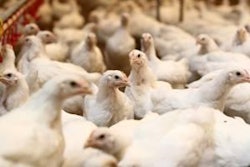
Genetic selection for fast growth in the broiler industry continues apace - chicks weighing only 40-45 g at day-old now reach some 2-2.2 kg by 40 days of age. The magnitude of this growth indicates that every day in the broiler’s life is important in reaching target weight. The higher the genetic potential of a bird, the greater the challenge for the nutritionists to develop a diet that fully exploits that potential.
When formulating diets to optimize productivity, several areas should be considered. Of these, early chick nutrition is one of the most important, as the first seven days of life account for 20% of the bird’s total lifespan (marketable age 35 days).
This importance is likely to increase. With further improvements in genetic potential (54 g improvement in weight per year), it can be expected that the marketable age will be reduced by one day per year, and thus the initial seven days will account for 25-30% of lifespan.
As time to market is progressively decreasing, and the immediate post-hatch period an increasing proportion of total production time, early nutrition can help to support the modern broiler to achieve its full genetic potential.
Among those areas that need particular attention during the early post hatch period are:
• Early development of the gastrointestinal tract and internal organs. At hatching, the chick’s digestive system is anatomically immature and its functional capacity is not fully developed. The gastrointestinal tract undergoes morphological (increase in length, villus height and density) and physiological changes (increases in the production of pancreatic and digestive enzymes) including increased surface area during the post hatch period. The small intestine increases in weight more rapidly than the whole body mass and this process of rapid relative growth is maximal at 6-10 days. Therefore, nutrition at this stage needs to be designed for healthy and early growth of internal organs and gastrointestinal tract development.
• Development of the immune system. The immune system of the bird is only partly developed at hatch. Gut associated lymphoid tissue (GALT), a component of the gut immune system, has evolved to provide protection against pathogens found in feed and the environment. Many changes occur in the GALT, including changes in T and B lymphocyte numbers, innate immune cells, enlargement of the bursa, appearance of caecal tonsils and Peyer’s Patches. Many research reports have suggested chickens in the first week post hatch lack adequate immune responsiveness and therefore are highly susceptible to infections. Consquently, nutritional strategy should be aimed not only at the development of the immune system, but also at adequate immune response.
• Alleviating stress. In modern poultry production systems birds are inevitably exposed to considerable stress. The gastrointestinal tract of the newly hatched chick is immature and sterile and only begins to develop its function and its microflora when it begins to ingest feed. Feed inevitably contains microorganisms and other components what may be toxic, and this puts additional stress on the bird either through diseases or activation of the immune system. Minimizing stress through nutritional manipulation at this stage is clearly important.
• Early access to feed and water. The time between hatching and the start of receiving nutrition is critical. However, in commercial poultry operations, the poultry hatch over a two-day period and are transferred from the incubator only when the majority of them clear the shell. Following removal from the incubator, other practices, such as sexing, vaccination and packaging are carried out before they are boxed and transported to farms. In practice, time of access to feed and water after hatching varies and long delays until placement are common.
The day immediately after hatch is critical for chick survival. On the very same day, the hatchling has to switch from a yolk nutrient based diet (mainly fats) to a solid feed diet (mainly carbohydrate and proteins).
Immediately after hatch, the chick draws from its limited reserves and undergoes rapid physical and functional development of the gastrointestinal tract in order to digest feed and assimilate nutrients.
As the intestine is the primary nutrient supply organ, the sooner it develops its functional capacity, the faster the young chick can utilize dietary nutrients and grow to its genetic potential and resist infectious and metabolic disease. Early access to feed and water is desirable in order to encourage better growth performance. A good start can help to ensure higher body weight, and there is a positive relationship between first week weights and final body weight (Fig 1).
In field conditions, most chicks receive feed and water 36-48 hours after hatching, which results in the mobilization of body reserves to support metabolism and thermal regulation, decreases body weight and impairs overall performance.
In looking at the effect of post-hatch feed deprivation up to 48 hours it was found that chicks deprived of feed up to 48 hours lost 4.7g, however, those given immediate access to feed gained 11.3g weight over the same period (Fig 2).
An important observation during the study was that delaying access to feed and water during the initial 48 hours of life had a long term physiological effect.
The loss in body weight associated with feed deprivation during 48 hours post hatch is perpetuated through to marketing. However, feed deprivation for an initial 24 hours after hatch had no adverse effect on performance. The birds fed immediately after hatch gained 6.3% higher weight at marketable age compared to those deprived of feed for an initial 48 hours post hatch.
The most important benefits of early feeding are enhanced body weight accompanied by an increase in breast meat percentage. This may be due to differential development of the skeleton and muscles, or to long term effects initiated by early feeding.
It has been suggested that poor nutritional status after hatch may inhibit mitotic activity of satellite cells and consequently breast muscle size. It has been reported in broiler chicks that the process of proliferation and differentiation of satellite cells is transient, but crucial, occurring in the first days post hatch, after which the satellite cell population declines dramatically. Post hatch starvation decreases satellite proliferation and skeletal muscle growth. Thus it is hypothesized that early access to feed after hatch enhanced satellite cell proliferation and stimulated skeletal muscle growth in broilers thereby increasing breast meat.
A similar finding has been observed in our own studies. Post hatch feed deprivation for 48 hours reduced the final dressed yield and breast meat yield (Fig 3). Chicks allowed to feed immediately after hatch reached higher dressed weight by 1% and breast meat yield by 3.3% during slaughter compared to those deprived of feed for an initial 48 hours after hatch. Thus, it can be concluded that one of the most important strategies for maximizing growth as well as carcass yield is allowing chicks to feed without delay.
Early feeding has an overall, long-term effect on growth performance, dressed weight and breast meat yield. Thus, appropriate nutrition and access to feed immediately post hatch avoiding any delay will definitely make the broiler industry a more profitable enterprise.

.jpg?auto=format%2Ccompress&fit=crop&h=167&q=70&w=250)
.jpg?auto=format%2Ccompress&fit=crop&h=167&q=70&w=250)












